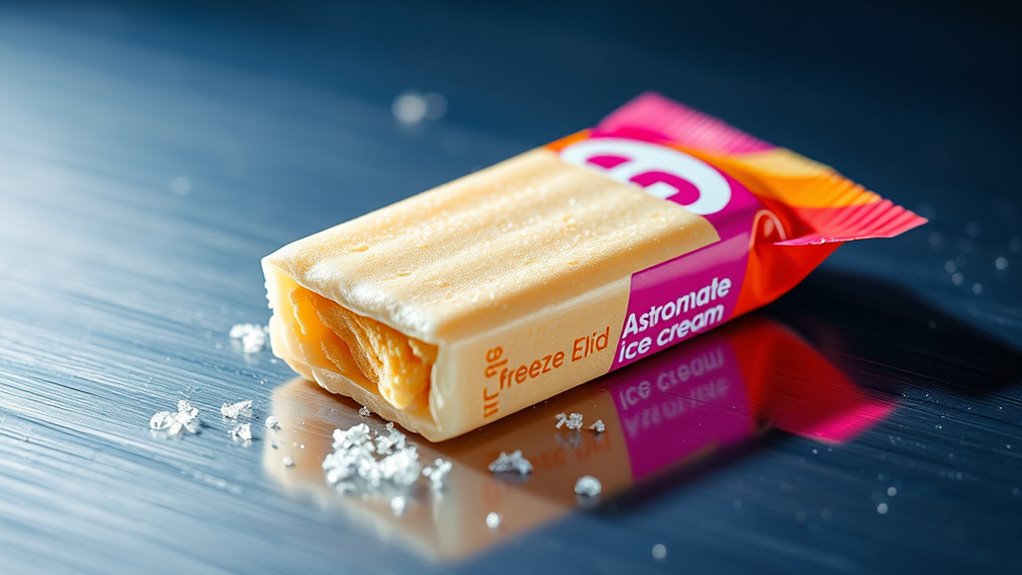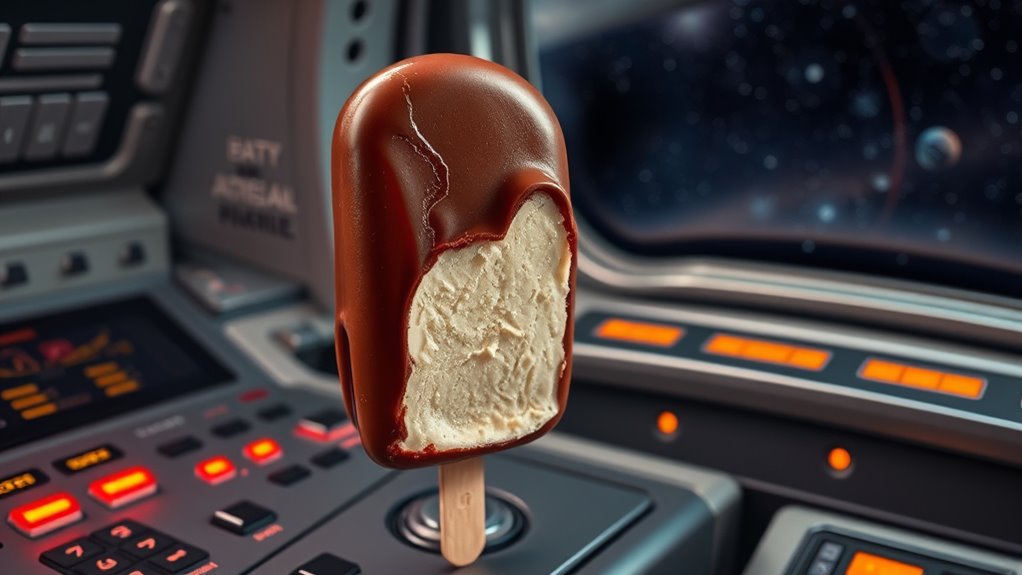Astronaut ice cream, or freeze-dried ice cream, is a space exploration treat designed to be light, stable, and easy to store. It’s made by freezing the ice cream and then removing the moisture through sublimation, which gives it a crispy, crumbly texture and a long shelf life. This clever food technology reflects how science adapts everyday foods for space. Keep exploring to discover more about this fascinating space snack and its unique history.
Key Takeaways
- Astronaut ice cream is freeze-dried, allowing it to be lightweight, stable, and suitable for space storage without refrigeration.
- The freeze-drying process involves freezing the ice cream and sublimating the ice under low pressure to preserve texture and flavor.
- Its crispy, crumbly texture results from water removal, differentiating it from traditional creamy ice cream.
- Originally created to provide astronauts a taste of home, it has become a cultural icon and popular space-themed treat.
- The technology behind astronaut ice cream exemplifies how food science adapts to meet the unique demands of space travel.

Astronaut ice cream, also known as freeze-dried ice cream, is a popular treat that has become synonymous with space exploration. When you think of space food, this is often the first image that comes to mind—colorful, crispy, and ready to eat without any refrigeration. The story behind astronaut ice cream is a fascinating blend of science and innovation, rooted in the development of freeze drying techniques that revolutionized how food is preserved for space missions. These techniques allow food to retain much of its original flavor, texture, and nutritional value while shedding nearly all its water content.
Astronaut ice cream, a freeze-dried treat, combines science and innovation to preserve flavor and texture for space exploration.
The process begins with the freezing of the ice cream, which is then subjected to a process called sublimation. During sublimation, the ice transitions directly from a solid to a gas under low pressure, bypassing the liquid phase entirely. This is the core of freeze drying techniques, which are employed to remove moisture efficiently while preserving the food’s structure. For space food, this method is invaluable because it substantially reduces weight and prevents spoilage, making it ideal for long journeys beyond Earth’s atmosphere.
When you hold a piece of astronaut ice cream, you notice its unique texture—crispy, crumbly, yet surprisingly flavorful. This texture results from the removal of water, which normally helps keep ice cream soft and creamy. The freeze-dried treat is stable at room temperature, requires no refrigeration, and can be stored for extended periods—perfect qualities for space missions. Its production involves carefully controlling temperature and pressure conditions to ascertain the ice cream maintains its integrity during the drying process. Once dried, it’s packaged in airtight containers to prevent moisture reabsorption, keeping it fresh until you’re ready to enjoy it.
The innovation behind astronaut ice cream highlights how advancements in food technology can meet the stringent demands of space travel. It’s a testament to how scientists and engineers adapt everyday foods for extraordinary environments. Although it was originally designed to provide astronauts with a taste of home, it has since become a cultural icon, enjoyed by space enthusiasts and curious consumers alike. Its presence in museums, gift shops, and science centers continues to inspire interest in space exploration and food science.
In the end, astronaut ice cream isn’t just a novelty; it exemplifies how freeze drying techniques make space food practical and accessible. It allows you to experience a piece of space history with every bite, connecting you to the pioneering spirit that drives us beyond our planet.
Frequently Asked Questions
How Is Astronaut Ice Cream Produced and Packaged?
You might wonder how astronaut ice cream is made and packaged. It starts with the freeze drying process, where ice is removed from the ice cream while preserving flavor and texture. Then, the dried ice cream is sealed in special packaging materials that keep it fresh and prevent spoilage. This method guarantees the ice cream remains lightweight and stable for space travel, making it easy to store and enjoy on missions.
What Flavors Are Available for Space Ice Cream?
Imagine a galaxy of flavors at your fingertips! Space ice cream offers a surprising flavor diversity, including classics like vanilla, chocolate, and strawberry, along with more adventurous options like cookies and cream or mint. These space treats are designed to delight your taste buds even in zero gravity. Whether you crave familiar favorites or want to explore new flavors, space ice cream guarantees you a sweet escape among the stars.
How Long Does Astronaut Ice Cream Stay Fresh?
You might wonder how long astronaut ice cream stays fresh. Its shelf life depends on storage conditions; keep it in a cool, dry place away from sunlight. Proper storage can preserve its quality for up to a year or more. Exposure to heat or moisture shortens its freshness, so always check the packaging date and store it correctly to enjoy the treat at its best.
Can Astronaut Ice Cream Be Eaten in Zero Gravity?
Did you know that astronauts can enjoy ice cream in space? In zero gravity, consumption becomes a fun challenge because taste perception changes. You’d use a special spoon or squeeze tube to eat astronaut ice cream, making zero gravity consumption possible. While it might feel different, the treat’s flavor stays pretty much the same. So, yes, you can eat astronaut ice cream in zero gravity, and it’s a tasty space adventure!
Is Astronaut Ice Cream Considered a Healthy Snack?
You might wonder if astronaut ice cream is a healthy snack. It generally has a high calorie count and includes added sugars and preservatives, which can affect your nutritional content negatively. While it’s convenient and tasty, it’s not the best choice for a nutritious diet. If you’re looking for a healthier option, consider fresh fruit or nuts, which offer better nutritional value and fewer empty calories.
Conclusion
As you imagine biting into astronaut ice cream, remember it’s more than just a treat—it’s a symbol of human curiosity and innovation. Like a childhood dream of floating among stars, this frozen delight reminds us that even the simplest pleasures can reach extraordinary heights. When astronauts first tasted it in space, it was a taste of adventure and discovery, proving that with imagination, we can turn the impossible into reality.









